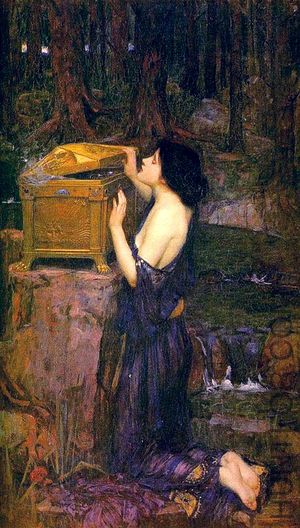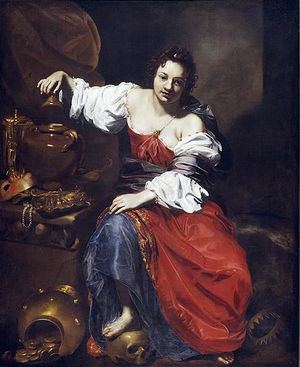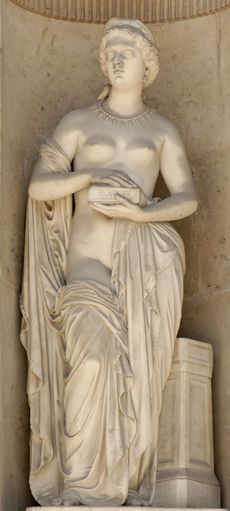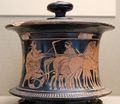پاندورا
(تم التحويل من باندورا)
هذا الموضوع عن پاندورا (توضيح). من أجل استخدامات أخرى، انظر پاندورا (توضيح).

John William Waterhouse: پاندورا، 1896
پاندورا هي أول أمرأة يونانية وجدت علي الأرض طبقا للعقيدة اليونانية. خلقت بامر من زيوس، وتم خلقها حسب الأسطورة من الماء والتراب ومنحت العديد من المزايا مثل الجمال والإقناع و عزف الموسيقى. حسب الأسطورة كان هناك صندوق منعت باندورا من فتحه ولكن حبها للفضول دفعها لفتح الصندق الذي ادى بدوره حسب الأسطورة إلى خروج الشياطين وإنتشارهم في الأرض.

Nicolas Régnier: Allegory of Vanity — Pandora, c. 1626. Régnier portrayed Pandora with a jar, not a box.
. . . . . . . . . . . . . . . . . . . . . . . . . . . . . . . . . . . . . . . . . . . . . . . . . . . . . . . . . . . . . . . . . . . . . . . . . . . . . . . . . . . . . . . . . . . . . . . . . . . . . . . . . . . . . . . . . . . . . . . . . . . . . . . . . . . . . . . . . . . . . . . . . . . . . . . . . . . . . . . . . . . . . . . .
انظر أيضاً
الهامش
المصادر
- Athanassakis, A. Hesiod: Theogony, Works and Days, Shield (New York 1983).
- Beall, E. "The Contents of Hesiod's Pandora Jar: Erga 94–98," Hermes 117 (1989) 227–30.
- Harrison, Jane Ellen, Prolegomena to the Study of Greek Religion (1903) 1922, pp. 280–85.
- Griffith, Mark. Aeschylus Prometheus Bound Text and Commentary (Cambridge 1983).
- Hesiod, Works and Days On-line text.
- Hesiod, Works and Days, ed. with prolegomena and commentary (Oxford 1978).
- Hesiod, Theogony, and Works and Days (Oxford 1988).
- Kenaan, Pandora's Senses: The Feminine Character of the Ancient Text (Madison, WI: The University of Wisconsin Press, 2008), pp. xii, 253 (Wisconsin Studies in Classics).
- Kirk, G.S., Myth: Its Meaning and Functions in Ancient and Other Cultures (Berkeley 1970) 226–32.
- Lamberton, Robert, Hesiod, New Haven: Yale University Press, 1988. ISBN 0300040687. Cf. Chapter II, "The Theogony", and Chapter III, "The Works and Days", especially pp. 96–103 for a side-by-side comparison and analysis of the Pandora story.
- Leinieks, V. "Elpis in Hesiod, Works and Days 96," Philologus 128 (1984) 1–8.
- Moore, Clifford H. The Religious Thought of the Greeks, 1916.
- Neils, Jenifer, The Girl in the Pithos: Hesiod’s Elpis, in "Periklean Athens and its Legacy. Problems and Perspectives", eds. J. M. Barringer and J. M. Hurwit (Austin : University of Texas Press), 2005, pp. 37–45.
- Nilsson, Martin P. History of Greek Religion, 1949.
- Phipps, William E., Eve and Pandora Contrasted, in Theology Today, v.45, n.1, April 1988, Princeton: Princeton Theological Seminary.
- Pucci, Pietro, Hesiod and the Language of Poetry (Baltimore 1977)
- Rose, Herbert Jennings, A Handbook of Greek Literature; From Homer to the Age of Lucian, London, Methuen & Co., Ltd., 1934. Cf. especially Chapter III, Hesiod and the Hesiodic Schools, p. 61
- Smith, William, Dictionary of Greek and Roman Biography and Mythology, 1870, sub "Pandora" On-line text
- William Smith, Dictionary of Greek and Roman Biography and Mythology (1870) vol I:177, sub "Anesidora" "Spender" is a misprint of "sender", often repeated.
- Verdenius, Willem Jacob, A Commentary on Hesiod Works and Days vv 1–382 (Leiden: E.J. Brill, 1985). ISBN 9004074651. This work has a very in-depth discussion and synthesis of the various theories and speculations about the Pandora story and the jar. Cf. p. 62 and onwards.
- Vernant, J. P., Myth and Society in Ancient Greece (New York 1990) 183–201.
- Warner, M., Monuments and Maidens: The Allegory of the Female Form (New York 1985) 213–40
- West, M. L. Hesiod, Theogony, ed. with prolegomena and commentary (Oxford 1966).
- West, M. L. Hesiod, Works and Days, ed. with prolegomena and commentary (Oxford 1978).
- Zeitlin, Froma. Playing the Other: Gender and Society in Classical Greek Literature (Princeton 1995).
وصلات خارجية
المصادر
الكلمات الدالة:




